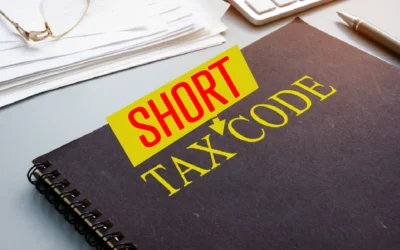Let’s talk about something nobody really loves: taxes. The mere mention of the word can make you want to curl up and hide until April 16th. But what if you could change that feeling from dread to control? It starts by looking at your money through a different lens, using tax planning strategies to keep more of what you earn.
Getting ahead of the game with a few key moves isn’t just for the super-rich; it’s for anyone who’d rather see their money in their own account instead of Uncle Sam’s. A sound financial plan should always include a thoughtful approach to managing your income taxes. You work hard for your money, so it just makes sense to learn how the rules work.
You don’t have to be a tax whiz to make a real difference in your financial life. We’re going to walk through some ideas that can help you feel more confident. You’ll learn how to think about your taxes all year, not just when it’s time to file.
Table of Contents:
- Know Your Tax Bracket
- Deductions vs. Credits: The Superheroes of Tax Savings
- Year-Round Tax Planning Strategies That Really Work
- Shelter Your Hard-Earned Cash in Tax-Advantaged Accounts
- Smart Investment Tax Strategies
- Gifting and Estate Planning
- Conclusion
Know Your Tax Bracket
Before you can make any smart moves, you need to know where you stand. The U.S. uses a progressive tax system, meaning higher incomes pay higher tax rates. But here’s the part that most people miss: you don’t pay your top tax rate on all of your income.
Think of your gross income like a stack of buckets. The government takes a little from the first bucket at a low rate, then a bit more from the second bucket at a slightly higher rate, and so on. According to the IRS, there are seven federal tax brackets for 2024: 10%, 12%, 22%, 24%, 32%, 35%, and 37% for ordinary income.
For example, say you’re a single filer with $60,000 in taxable income. You fall into the 22% bracket, but you won’t pay 22% on that whole sixty grand. You’ll pay 10% on the first chunk, 12% on the next, and only 22% on the income that actually falls into that top bracket. Knowing this helps you see that every dollar you can legally shield from taxes saves you money at your highest marginal rate.
Deductions vs. Credits: The Superheroes of Tax Savings
Tax deductions and tax credits are the two best things about tax time because they both shrink your bill. But they work in very different ways, and one is much more powerful. Understanding this difference is a cornerstone of solid financial planning.
A tax deduction lowers your taxable income. If you’re in the 22% tax bracket, a $1,000 deduction saves you $220. It’s good, but a tax credit is even better.
A tax credit gives you a dollar-for-dollar reduction of your actual tax bill. A $1,000 tax credit cuts your tax bill by, you guessed it, a full $1,000. It’s a direct discount on what you owe, making it a more impactful tax benefit.
Here’s a quick look at how that plays out:
| $1,000 Deduction | $1,000 Credit | |
|---|---|---|
| Your Income | $75,000 | $75,000 |
| Deduction | -$1,000 | $0 |
| Taxable Income | $74,000 | $75,000 |
| Tax Owed (approx. 22%) | $16,280 | $16,500 |
| Credit | $0 | -$1,000 |
| Final Tax Bill | $16,280 | $15,500 |
As you can see, the credit puts a lot more money back in your pocket. The goal is to hunt for every single credit and deduction you qualify for on your tax return. Talking to a tax advisor can help you find credits and tax deductions you may not know about.
Year-Round Tax Planning Strategies That Really Work
Tax planning isn’t a one-time event you cram into a weekend. It’s a series of small, smart choices you make all year. Making these moves a part of your financial routine can completely change your tax outcome for the current tax year and beyond.
The Big Decision: Standard or Itemized Deduction
Every taxpayer gets to choose between taking the standard deduction or itemizing their deductions. The standard deduction is a set amount determined by your filing status that you can subtract from your income. It’s simple, easy, and requires no extra paperwork.
Itemizing means you add up all of your individual, eligible deductible expenses one by one on what’s known as Schedule A. You’d typically itemize if your total itemized deductions are greater than the standard deduction for your filing status. For many, this decision comes down to a few key expenses, like mortgage interest or large charitable contributions.
For example, a married couple might find that their combined state taxes, property taxes on their real estate, and mortgage interest exceed the standard deduction, making itemizing the better choice. Tax software makes this easy by calculating it both ways and showing you which path saves you more money. This is a critical part of any tax strategy.
Level Up Your Record Keeping
I know, I know. Keeping records sounds like a total bore. But think of it as your financial armor. If the IRS ever sends you a letter asking questions, having organized records turns a potential crisis into a minor inconvenience, especially with complex tax law.
The general rule is to keep tax documents for at least three years, as that’s the typical window the IRS has to audit your tax return. Keep records for at least six years if you underreport your income by more than 25%. Records related to property, like a home or investments in mutual funds, should be kept for as long as you own it, plus three years after you sell it.
- Income Records: Keep all your W-2s, 1099s, and statements from banks or brokerages. This includes information on stock option exercises.
- Expense Receipts: For any deductions you plan to itemize, such as medical bills, property tax payments, and receipts for a charitable contribution.
- Investment Info: Records showing when you bought and sold assets are critical for figuring capital gains tax and proving your cost basis.
Fine-Tune Your Paycheck with a W-4 Adjustment
Your Form W-4 is one of the most powerful but overlooked tools for tax planning. This is the form you give your employer that tells them how much tax to withhold from each paycheck. Most of us fill it out on our first day and never think about it again.
But life changes. Did you get married, have a baby, or start a side hustle? These events affect your tax situation. By adjusting your W-4, you can get closer to your actual tax liability with each check, especially if you are a married couple filing jointly.
Getting a huge refund might feel like a bonus, but it means you gave the government an interest-free loan all year from your savings account. On the other hand, owing a lot of money in April can be a painful shock. Tweaking your W-4 helps you find that sweet spot so you have more money in your hands throughout the year without owing a big bill at the end.
Use Estimated Tax Payments for Non-W2 Income
If you have income from sources other than an employer, such as freelancing, a side business, or investments, you may need to pay estimated tax. The IRS requires you to pay taxes as you earn income throughout the year. Failure to do so can result in penalties.
You can pay estimated tax quarterly using Form 1040-ES. Calculating the right amount can be tricky, as you have to project your annual income and deductions. This is another area where working with a financial advisor can provide valuable guidance and prevent unpleasant surprises.
Shelter Your Hard-Earned Cash in Tax-Advantaged Accounts
Now we get to the fun stuff. One of the best tax strategies involves using accounts that give you a tax break just for saving for your future. It’s a true win-win that builds long-term wealth.
Maximize Your Workplace Retirement Plan
Putting money into a traditional 401(k) at work is a classic move for a reason. Every dollar you contribute lowers your taxable income for the year. For 2024, the contribution limit is $23,000, with an additional $7,500 in catch-up contributions for those age 50 and over.
Many employers also offer a match on your contributions, which is essentially free money. Contributing at least enough to get the full match should be a top priority in your retirement plan. This simple action can dramatically boost your savings over time.
Choose the Right IRA: Traditional vs. Roth
If your job doesn’t offer a 401(k), or if you want to save more, an Individual Retirement Arrangement (IRA) is your best friend. The two main types are the traditional IRA and the Roth IRA. The annual IRA contribution limit for 2024 is $7,000, with a $1,000 catch-up if you are 50 or older.
A traditional IRA may allow you to deduct your contributions, lowering your income tax bill today. Your investments grow tax-deferred, and you pay ordinary income tax on withdrawals in retirement. This can be a great option if you expect to be in a lower tax bracket during your retirement years.
With a Roth IRA, your contributions are made with after-tax dollars, so there’s no upfront deduction. However, your money grows completely tax-free, and qualified withdrawals in retirement are also tax-free. If you expect to be in a higher tax bracket later in life, a Roth IRA can be an incredibly powerful tool.
The Triple-Tax-Advantaged HSA
A Health Savings Account, or HSA, is another amazing tool if you have a high-deductible health plan. It offers a triple tax advantage that is hard to beat for health savings. It is one of the most effective tax strategies available for those who qualify.
Your contributions are tax-deductible, lowering your current year’s tax bill. The money in the account grows tax-free. Finally, withdrawals for qualified medical expenses are also completely tax-free at any time.
Many people use their HSA as a supplemental retirement plan. After age 65, you can withdraw money for any reason and only pay ordinary income tax, just like a traditional IRA. But if you use it for medical costs, it remains tax-free forever.
Smart Investment Tax Strategies
How you manage your investments can have a big impact on your tax bill. Paying attention to tax efficiency can help your portfolio grow faster. These strategies focus on minimizing the tax drag on your investment products.
Harvest Your Losses to Offset Gains
Nobody likes to see an investment lose value, but you can turn that loss into a tax-saving opportunity through tax-loss harvesting. This strategy involves selling an investment that is down to realize a capital loss. That capital loss can then be used to offset capital gains from other investments.
If your capital losses exceed your capital gains for the year, you can use up to $3,000 of the excess loss to offset your ordinary income. Any remaining losses can be carried forward to future tax years. This is a common practice used to manage the tax impact of a portfolio of stocks, bonds, or mutual funds.
Asset Location for Tax Efficiency
Asset location is different from asset allocation. It’s the practice of placing different types of investments in the accounts where they will be taxed most favorably. This can significantly reduce the taxes you pay on your investment returns over the long term.
For example, assets that generate high taxes, like corporate bonds that produce taxable interest (fixed income), are often best held in a tax-advantaged retirement account like a 401(k) or IRA. Assets that are more tax-efficient, like stocks held for over a year to get favorable long-term capital gains tax rates, can be held in a regular taxable brokerage account. Proper asset location boosts your after-tax returns without changing your overall investment mix.
Plan for Charitable Giving
If you are charitably inclined, there are tax-smart ways to give. While writing a check is simple, it may not be the most tax-efficient method. A more potent charitable contribution strategy involves donating appreciated assets.
Instead of selling a stock or mutual fund that has gone up in value and then donating the cash, you can donate the asset directly to the charity. By doing this, you can generally take a charitable deduction for the full market value of the asset. Plus, you avoid paying any capital gains tax on the appreciation.
Gifting and Estate Planning
Thinking about your legacy might seem far off, but simple estate planning moves can have tax benefits now and for your heirs later. The tax law around this can be complex, so it’s often a good idea to consult a professional. But the basics are helpful for everyone to understand.
Each year, you can give up to a certain amount to any individual without having to pay a gift tax or file a gift tax return. For 2024, this annual exclusion amount is $18,000 per person. A married couple could combine their exclusions and give up to $36,000 to a single individual.
This can be a straightforward way to help family members or reduce the size of your taxable estate over time. While most people will not have an estate large enough to trigger federal estate taxes, these rules can be very important for those who do. It’s a part of a comprehensive financial plan that looks at the big picture of your wealth.

Conclusion
Taking control of your finances feels good. Applying smart tax planning strategies isn’t about finding secret loopholes or being dishonest. It’s about understanding the system and making it work for you, legally and ethically, to reduce your income taxes.
By getting familiar with your tax bracket, tax deductions, credits, and the power of retirement accounts, you can build a stronger financial future. Investing with tax efficiency in mind through tactics like tax-loss harvesting can further enhance your results. The best tax strategies are the ones you actually use, so start with one or two of these ideas and build from there.



